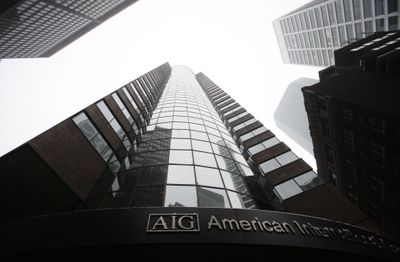Latest AIG bailout likely won’t be last

WASHINGTON – A new definition of desperate times: Even as the government threw a stunning new $30 billion lifeline to American International Group on Monday, the beleaguered insurance giant confirmed it had lost more than twice that much – $62 billion – in a single three-month period.
And many more billions of federal dollars are almost sure to be shoveled into the company for a simple reason: Officials fear its collapse would cripple financial markets in the U.S. and around the world.
The source of trouble for AIG, which has 74 million customers worldwide and operations in more than 130 countries, is its business insuring mortgage-backed securities and other debt against default. That business imploded once the credit crisis struck with force.
The government has now made four separate efforts to save the company, totaling more than $170 billion.
AIG is so big and sprawling, so intertwined with institutions around the globe, that its downfall could set off a vicious chain reaction. Upheaval on such a global scale could plunge the U.S. economy deeper into recession, drive up unemployment and stifle hopes for an economic rebound anytime soon.
The company provides life, property and other insurance offerings, with 30 million policyholders in the United States alone. It also provides asset-management services and airplane leases.
Its International Lease Finance Corp., which leases jets to airlines, has been up for sale and was thought to be one of the insurer’s jewels. But falling travel demand has forced airlines to shrink fleets.
AIG’s businesses also are linked to mutual funds, annuities and other retirement products held by many Americans.
“Given the systemic risk AIG continues to pose and the fragility of markets today, the potential cost to the economy and the taxpayer of government inaction would be extremely high,” the Treasury Department and the Federal Reserve said in a joint statement Monday.
Turning AIG into a smaller, more viable company, “will take time and possibly further government support,” the Treasury and the Fed acknowledged.
Indeed, many analysts say the United States will eventually be forced to funnel billions more into the company, which the government seized control of last year. And they say AIG has become a seemingly bottomless money pit that poses a cautionary tale about the effectiveness of U.S. bailouts.
Mark Williams, professor of finance and economics at Boston University and a former Federal Reserve bank examiner, said he thinks at least $200 billion more will have to be extended to AIG.
“AIG is holding the U.S. government hostage at gunpoint,” Williams said. “The government can’t cut its losses because it is too far into AIG. It has no choice but to keep on pumping money into the company.”
At the White House, press secretary Robert Gibbs said, “We’re focused on taking the steps necessary to restructure AIG so that it, in the long run, no longer poses the type of systemic threat that it poses right now.”